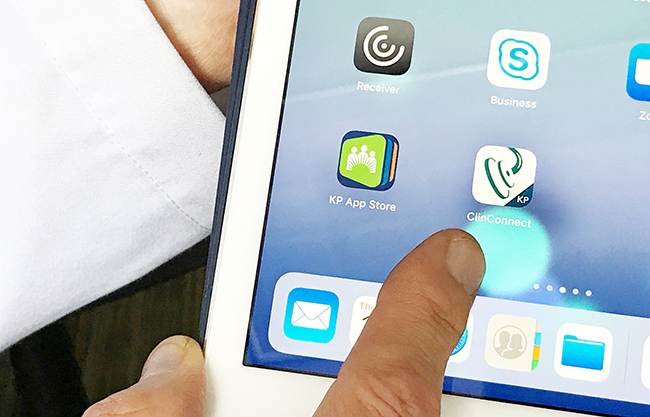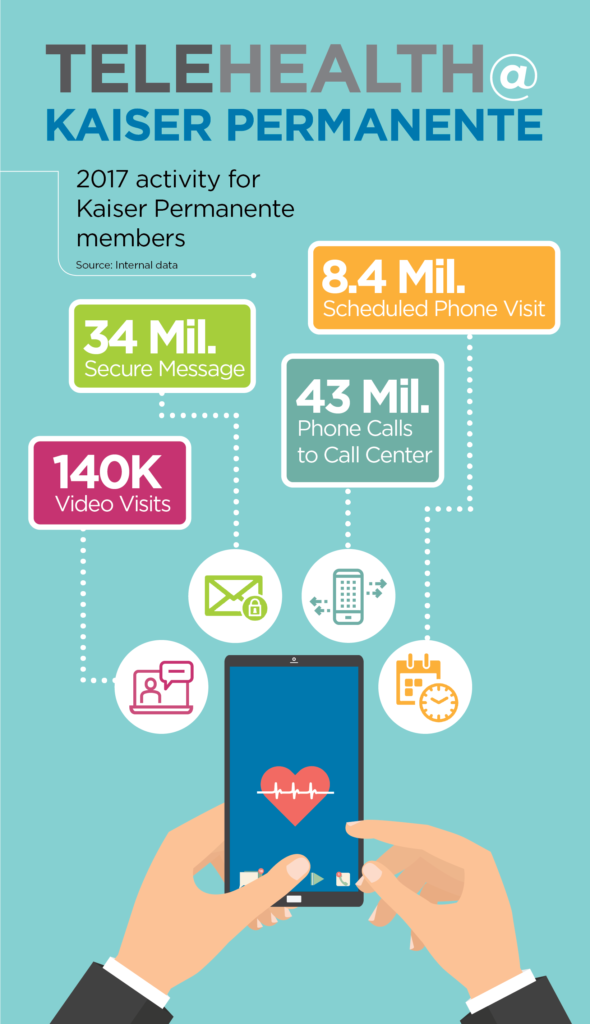New AI-powered patient portal boosts patient access, safety, and satisfaction.

Kaiser Permanente invests in telemedicine that helps improve care for its patients, such as the Clinician Connect app to allow doctors to easily consult with specialists.
Convenience, Choice, Connectivity
Kaiser Permanente Telehealth Initiatives Help to Improve Quality Care for Patients
By Benjamin Seto
The Permanente Federation
In much of the country, telehealth is seen as an answer to rural patients’ inability to access care through traditional doctor’s office visits. But at Kaiser Permanente – whose members receive care at company-owned or contracted hospitals and medical offices in eight states and the District of Columbia – telehealth initiatives provide convenience and choice to its more than 12 million members, while also providing access to those in distant locations.
Telehealth, or telemedicine, which incorporates technology to improve the delivery of clinical care, is increasingly a focus for many health care organizations trying to keep up with other industries disrupted by innovation and new technology. About 70 percent of health care providers use some form of telehealth tools, according to a 2017 HIMSS Analytics report.
“The world is a busy place, and we utilize technology to manage many aspects of our lives,” says Patricia Conolly, MD, executive vice president and chief information officer at The Permanente Federation, which represents the national interests of the eight physician-led Permanente Medical Groups that provide care exclusively to Kaiser Permanente patients.
“What we seek to do at Kaiser Permanente is to make care convenient and to give patients a choice in how they access care within clinically appropriate guidelines,” she says, adding that telehealth also increases the connection between patients and their clinicians, enabling more contact outside of the traditional office visit.
The world is a busy place, and we utilize technology to manage many aspects of our lives.
– Patricia Conolly, MD, executive vice president and chief information officer, The Permanente Federation
For patients, a video or telephone visit with their doctor may be a convenient alternative to an office visit. “For a 20-minute office visit, there are estimates that a patient may spend as much as two to four hours away from work, home, or their regular activities,” says Dr. Conolly.
However, Dr. Conolly emphasized, patients who want to see a doctor in person still have that option. “Telehealth always has to be the patient’s choice,” she says, “and many times patients are more satisfied when they have the option to choose.”
From video visits to remote glucose monitoring of diabetes patients, Kaiser Permanente has invested in telemedicine with the goal of improving care and enhancing the experience of its patients. The close collaboration between the health plan and physician groups – the hallmark of the organization’s integrated care model – enables it to apply resources where needed to implement large-scale telemedicine initiatives. Over the years, Kaiser Permanente has received several industry awards for its use of technology to improve care.
Connecting Through KPATHS
Kaiser Permanente’s clinical call centers respond to more than 43 million telephone calls per year from patients wanting to book appointments, message clinicians, or get nurse advice. To improve this service, the organization is currently rolling out a new sophisticated application known as Kaiser Permanente Access to Health Systems, or KPATHS, which started at The Permanente Medical Group (TPMG) in Northern California.
 “KPATHS provides a better and more accurate experience for the call center agent to help reduce the time it takes to process these requests for members,” says Khang Nguyen, MD, virtual medical center physician director of the Southern California Permanente Medical Group (SCPMG) and SCPMG clinical call center physician lead. The application is being rolled out in phases in the region and is expected to be in all Kaiser Permanente Southern California call centers by summer 2019.
“KPATHS provides a better and more accurate experience for the call center agent to help reduce the time it takes to process these requests for members,” says Khang Nguyen, MD, virtual medical center physician director of the Southern California Permanente Medical Group (SCPMG) and SCPMG clinical call center physician lead. The application is being rolled out in phases in the region and is expected to be in all Kaiser Permanente Southern California call centers by summer 2019.
KPATHS allows representatives to know which doctors are accepting new patients and their availability for bookings. It also provides detailed information such as specialties, languages spoken, and clinicians designated as LGBTQ-friendly. In the past, clinician background information was kept in a variety of files and often would be segmented by service area. With KPATHS, the information is now all at the fingertips of the telephone representative.
Scott Tsunehara, MD, TPMG’s regional clinical director, Appointment and Advice Call Centers (AACC), says KPATHS also provides a new level of transparency for physicians. Notes gathered during calls are uploaded to the organization’s electronic health record. “As a physician,” Dr. Tsunehara says, “I can see information on KP HealthConnect gathered from the member by our AACC teleservice representatives, nurses, and physicians. We never had access to that level of detail in the past.”
KPATHS will eventually be implemented in all Kaiser Permanente regions, and will also be used to enhance the member’s online experience on kp.org.
Consultations Through Clinician Connect
Not all telemedicine initiatives are patient-facing. Some initiatives can improve operations among clinicians with the ultimate goal of improving clinical outcomes, Dr. Conolly says. One example of this is Clinician Connect.

An app developed for clinicians to use on their iPhones, Clinician Connect allows doctors to easily access a database of on-call specialists and then either call or text the colleague from the app. Physicians can quickly get a consultation – often while the patient is still there – so that the right care can be provided sooner.
“The idea is to be able to connect with another clinician, just like it says in the name, so we can expedite the care of our patients,” says Ed Lee, MD, medical director of the TPMG Technology Group and creator of the original prototype that eventually became Clinician Connect.
The app, which has been used in Kaiser Permanente Northern California for about three years, is now being piloted among physicians at the Mid-Atlantic Permanente Medical Group. If successful, it will eventually roll out to all Permanente clinicians.
“One of the easiest ways to know how well a product is working is whether people are using it,” Dr. Lee says. “In Northern California, clinicians use the ‘On Call’ tab of the app between 80,000 and 90,000 times a month.”
There are many innovative telehealth products today, but Dr. Conolly says it’s important for a large organization such as Kaiser Permanente to determine the value each brings to patient care. Sometimes the simpler technology may be the better answer. “There needs to be a balance of keeping our eyes open to what’s new and cool and potentially disruptive,” she says, “with what kind of things we can successfully implement and utilize consistently to make a difference.”


